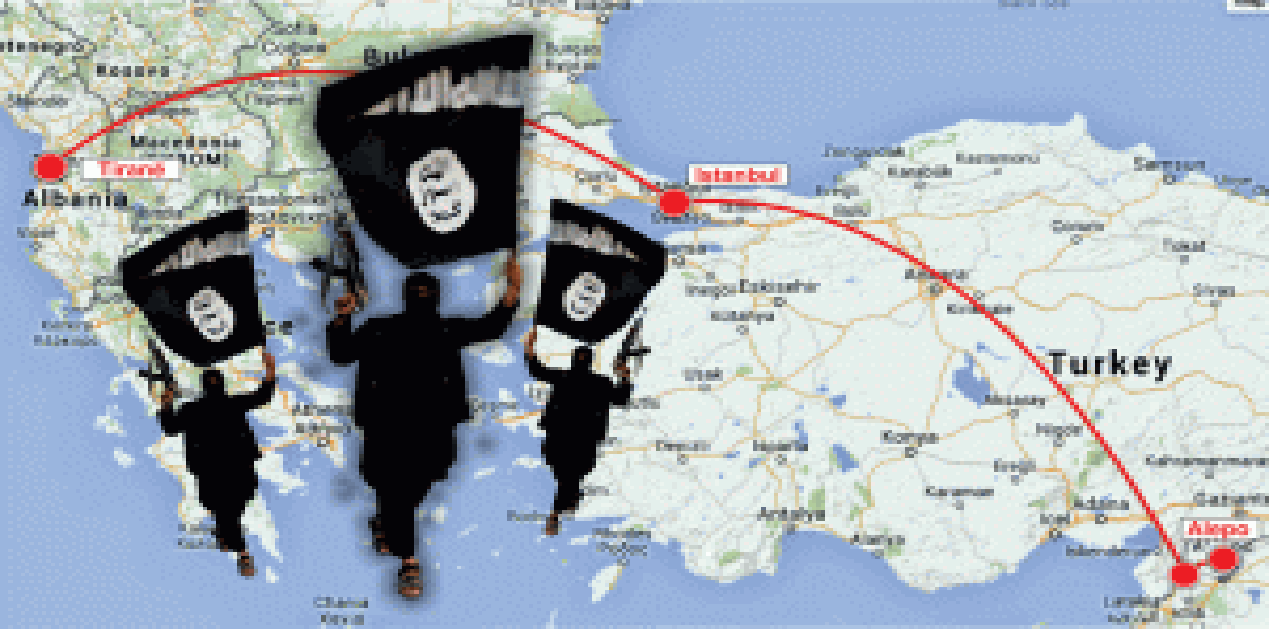The Islamic State of Iraq and Syria (ISIS) is a powerful group which is responsible for hundreds of terrorist attacks around the world and used to control large areas of Iraq and Syria in the size of the United Kingdom. ISIS is known around the world for carrying out heinous acts of violence, including public executions, rapes, beheadings and crucifixions. It became notorious through its ability of videotaping and uploading all these atrocities on the Internet.
This analysis examines the nature of ISIS by describing briefly the differences of the tactics and techniques used by the militant group in the areas of Middle East, Europe, USA, North Africa, and Nordic East Asia. The article focuses on the ISIS infiltration into Balkans as a threat to the regional stability.
The ISIS story started in 2004, when the organization known as ‘Al Qaeda in Iraq’ was formed by Abu Musab al-Zarqawi. Its leader was killed during a US airstrike in 2006 when the Egyptian Abu Ayyub al-Masri became the new leader and renamed the organization ‘Islamic State in Iraq’. In 2010, Al-Masri died in a US–Iraqi operation and Abu Bakr al-Baghdadi was named as the new leader of the group. When the Syrian civil war started in 2011, ISIS fought against Syrian forces and gained ground throughout the region. In 2013, the group officially renamed itself ‘Islamic State of Iraq and Syria’ due to its expansion to Syria (History, 2015).
In the second half of 2017 ISIS suffered consecutive defeats, such as losing its de facto capitals, Mosul in Iraq and Raqqa in Syria. However, it still remains a significant threat in the Middle East and in the West. This is because the organization is still able to conduct terrorist attacks in several areas worldwide and can still spread its propaganda through the social media and the Dark Web, an effective way to recruit members and supporters.
It is difficult to define whether this group is a terrorist, a guerilla or a criminal organization because its tactics differ from place to place (Dempsey, 2018). More specifically, the group acts as a guerilla organization in the areas of the Middle East to carry out surprise attacks and ambushes against the US-led coalition forces, while it acts as a terrorist organization in the areas of North-East Asia, North Africa, Europe and USA (Cockburn, 2018).
Tactics and Techniques
Since 2006, ISIS’s main goals have been the creation of an Islamic Caliphate and rejection of everything Western from the Middle East. To achieve that goal the organization has studied and incorporated lessons from the experience of other insurgent groups who have fought against the United States and have used many different tactics and techniques. Generally, ISIS seems to have a decentralized command structure rather than a top-down doctrinal learning format where tactical learning is left to the discretion of local emirs. The most common tactics and techniques of the group include use of Improvised Explosive Devices (IEDs), trucks packed with explosives and driven by suicidal drivers, chemical attacks, armed suicide missions, drone attacks, animal training, truck attacks against crowds and knife attacks. The group acts according to its means and the target area. For example, some tactics are effective if the target area is under some influence and accessible. That’s why the group uses different tactics in Middle East than in Europe.
More specifically, ISIS tended to employ large numbers of small and unsophisticated IEDs made with homemade explosives in order to limit the mobility and to raise the strategic costs of offensive action. Those devices are sufficient only to wound or kill a single combatant on foot. This strategy was adopted by the group most likely from the Taliban’s experience and it works only when the conflict is between irregular forces that operate in a territory. That means that ISIS would not be able to use this tactic in areas outside of Syria or Iraq.
Cars or trucks packed with explosives and driven by suicidal drivers play an important role as they provide ISIS the ability to accurately target enemy positions with high explosives. Most of these vehicles are mine-resistant or ambush-protected and are equipped with improvised armor to improve their survivability until they reach their target. Also, the windshield is replaced by bullet-resistant glass to protect the driver. This tactic is unlikely to be used in a Western city without the authorities taking notice (Cancian, 2017).
ISIS forces regularly employed chemical weapons against their enemies and occasionally against civilians. The most common substances used were mustard and chlorine gases, which were delivered against targets via mortars or rockets. The group has not used any chemical, biological or radiological weapon in areas outside of Middle East so far, but it is possible that this will happen in the future.
All of the abovementioned tactics are effective only when a group has some degree of influence over the targeted area. That’s why ISIS uses different tactics outside of the areas that they once used to control. For example, attacks in the West are less militarized and closer to terrorism, such as suicide missions, truck attacks and knife attacks.
Guerilla-Warfare Tactics
Not only was ISIS using different tactics according to its area of operation but has also changed its attacking methods after it lost the areas it used to control (Coker, 2017). More specifically, ISIS after losing its controlled areas adopted guerilla-warfare tactics with its commanders and fighters leaving cities and heading into the mountains (Rudaw, 2017). For example, after the liberation of Mosul in 2017, ISIS dug tunnels between streets and houses, which were used to move from one place to another without being seen and also to avoid direct confrontation or major engagements with the security forces (Rudaw, 2018). ISIS increasingly prefers to conduct hit-and-run operations while at the same time, its members are trying to blend in with the local population and hide within (Mouchantaf, 2018). The return of ISIS to the guerrilla warfare comes as part of an attempt to reorganize and regain bits of territory (Phillips, 2018).
ISIS in Balkans
One of the most worrying issues in Balkans is the infiltration of terrorist groups such as ISIS and Al Qaeda. Bosnian Muslims are the largest group from the Western Balkans fighting for Islamic State in Syria and Iraq, alongside fighters from countries such as Kosovo, Albania, FYROM, Montenegro and Serbia. The most remarkable examples are Kosovo and Bosnia & Herzegovina because along with the Islamic populations in their territories, both have the appropriate circumstances to cultivate extremist ideas and terrorism, such as poverty and a lack of state order.
Bosnia
According to the Bosnian Government, the greatest security threat in Bosnia today is believed to come from international terrorist groups such as ISIS, Al-Qaeda and the Al-Nusra Front. Since 2012, it is estimated that 350 Bosnian foreign fighters have traveled to conflict zones in Iraq and Syria. Bosnians represent the largest contingency of foreign fighters from the Western Balkans (Counter Extremism Project, 2017). Bosnia’s Muslims are generally moderate but some have adopted radical Salafi Islam from foreign fighters who came to the country during its 1992-95 war to fight alongside Muslims against Orthodox Serbs and Catholic Croats (Sito-Sucic, 2016).
ISIS sees Bosnia as a huge recruiting source and has invested a lot of money and human resources in order to recruit members and supporters. The group relies on in-person terrorist recruitment networks and it has launched video campaigns specifically targeting Bosnian Muslims (Counter Extremism Project, 2017). In November 2016, ISIS began translating its online magazine Rumiyah into Bosnian language.
Given that the citizens of Bosnia and Herzegovina can travel visa-free throughout the European Union, these home-grown terrorists can easily infiltrate Europe and launch attacks there. No surprise that Bosnian weapons and ammunitions found their way to the perpetrators of 2015 terror attack on Charlie Hebdo office in Paris where 12 people were slain and 11 wounded (The Institute for Stabilization and Transition, 2017).
In November 2015, Bosnia sentenced a major ISIS recruiter, Husein ‘Bilal’ Bosnic, to seven years of imprisonment after he was convicted of luring Bosnian groups to join ISIS abroad. Departures from Bosnia and returns from Syria had almost completely stopped by early 2016 because Bosnian authorities were prosecuting the aspiring fighters as well as those who returned.
Kosovo
Since the end of the war in Kosovo in 1999, the threat of violent Islamic extremism has been growing, fueled by poverty, youth unemployment and funding from foreign sources that preach extremist ideologies. Money from religious groups based in Saudi Arabia and other Gulf nations has gone into building schools and mosques where Wahhabism, an ultra-conservative interpretation of Islam, is being taught (Teggarty, 2017). In Kosovo, there are increasing signs that the problem may be growing on Europe’s own doorstep, as a combustible mix of poor governance, economic stagnation, and lingering identity crises have created a unique vulnerability to recruitment by violent extremists (McCarthy, Waggoner, 2017). The influence of the radical clerics reached its apex with the war in Syria, as they extolled the virtues of jihad and used speeches and radio and television talk shows to urge young people to join ISIS in Syria (Gall, 2016).
Since 2014, the police of Kosovo have identified more than 300 people who have joined ISIS abroad and fought in the Middle East. Those people, mostly young or vulnerable, were radicalized and recruited by extremist clerics inside Kosovo. The police has arrested more than 70 people, 14 imams and shut down 19 Muslim organizations for acting against the Constitution, inciting hatred and recruiting for terrorism.
Conclusion
The most common ISIS tactics of infiltration include spreading its propaganda through social networks, the Dark Web, in-person network recruitment, and Imams who promote violence and extremism. Since ISIS started losing ground, it motivated its members and supporters to return to their homelands and carry out terrorist attacks as ‘lone wolves’.
Infiltration of ISIS in the Balkans can destabilize the region and Europe. This is possible as the foreign fighters return home from the Middle East and pose threat to the regional and European security, being able to spread the group’s propaganda, spread radicalization and recruit more members. Those returning fighters, who use the migrant streams to return to Balkans as well as Europe in general, are well trained in the battle fields of Syria and Iraq, and they can conduct terrorist attacks on the European soil or provide material support to ISIS members.
References:
- History (2015) ISIS Available at https://www.history.com/topics/isis (Accessed: 12 May 2018).
- Dempsey M. (2018) How ISIS’s Strategy is Evolving Available at https://www.foreignaffairs.com/articles/syria/2018-01-18/how-isis-strategy-evolving (Accessed: 3 June 2018).
- Cockburn, P. (2018) Preview 2018: After a string of defeats in Iraq and Syria what 2018 means for ISIS Available at https://www.independent.co.uk/news/world/middle-east/isis-defeat-syria-latest-iraq-2018-survive-a8107891.html (Accessed: 8 July 2018).
- Cancian M. (2017) Tactics, Techniques, and Procedures of the Islamic State Available at https://www.armyupress.army.mil/Journals/Military-Review/English-Edition-Archives/March-April-2017/ART-009/ (Accessed: 1 July 2018).
- Coker, M. (2017) With Loss of its Caliphate, ISIS may return to Guerrilla Roots Available at: https://www.nytimes.com/2017/10/18/world/middleeast/islamic-state-territory-attacks.html (Accessed 22 June 2018).
- Rudaw (2017) With retaking of Mosul, ISIS sleeper cells and guerrilla warfare biggest threat Available at: http://www.rudaw.net/english/kurdistan/200720171 (Accessed: 12 July 2018).
- Rudaw (2018) Violent clashes as ISIS adopts guerrillas tactics, attacks SDF Available at: http://www.rudaw.net/english/middleeast/syria/04062018 (Accessed 15 July 2018).
- Mouchantaf, C. (2018) The ISIS tactics that have left Iraqi special forces weakened Available at: https://www.defensenews.com/digital-show-dailies/sofex/2018/05/08/the-isis-tactics-that-have-left-iraqi-special-forces-weakened/ (Accessed 11 June 2018).
- Philips, J. (2018) ISIS may be on the Run, but It’s Far from Finished Available at: https://www.heritage.org/middle-east/commentary/isis-may-be-the-run-its-far-finished (Accessed: 5 July 2018).
- Counter Extremism Project (2017) Bosnia & Herzegovina: Extremism &Counter – Extremism Available at: https://www.counterextremism.com/countries/bosnia-herzegovina (Accessed: 16 July 2018).
- Sito-Sucic D. (2016) Bosnian children with Islamic State are “time bomb”, study says Available at: https://www.reuters.com/article/us-mideast-crisis-bosnia/bosnian-children-with-islamic-state-are-time-bomb-study-says-idUSKCN0YZ1VC (Accessed: 13 July 2018).
- The Institute of Stabilization and Transition (2017) Bosnia and Herzegovina: Failed State in the Heart of Europe Available at: http://www.stabilizationandtransition.org/pdfs/IST-1508165727.pdf (Accessed: 25 June 2018).
- Teggarty N. (2017) Kosovo looks to ISIS wives in order to fight extremism Available at https://www.huffingtonpost.com/entry/kosovo-looks-to-isis-wives-in-order-to-fight-extremism_us_58c1ae33e4b054a0ea6900dd?guccounter=1 (Accessed: 17 July 2018).
- McCarthy P, Waggoner L. (2017) Terrorism on the Eastern Front Available at http://www.iri.org/resource/iri-experts-american-interest-kosovo-next-recruiting-ground-isis (Accessed: 11 July 2018).
- Gall C. (2016) How Kosovo was turned into fertile ground for ISIS Available at https://www.nytimes.com/2016/05/22/world/europe/how-the-saudis-turned-kosovo-into-fertile-ground-for-isis.html (Accessed: 17 July 2018).
Natalia Griva is an Austria-based Foreign Affairs and Counter-Terrorism Analyst.
(The paper is the author’s individual scholastic articulation. The author certifies that the article/paper is original in content, unpublished and it has not been submitted for publication/web upload elsewhere, and that the facts and figures quoted are duly referenced, as needed, and are believed to be correct). (The paper does not necessarily represent the organisational stance... More >>
Image Source: https://encrypted-tbn0.gstatic.com/images?q=tbn:ANd9GcR-Z63n2cz_IDbdjzKiNJy5MqKOrP1v6KBciZuynArunBdkzx5B










Post new comment